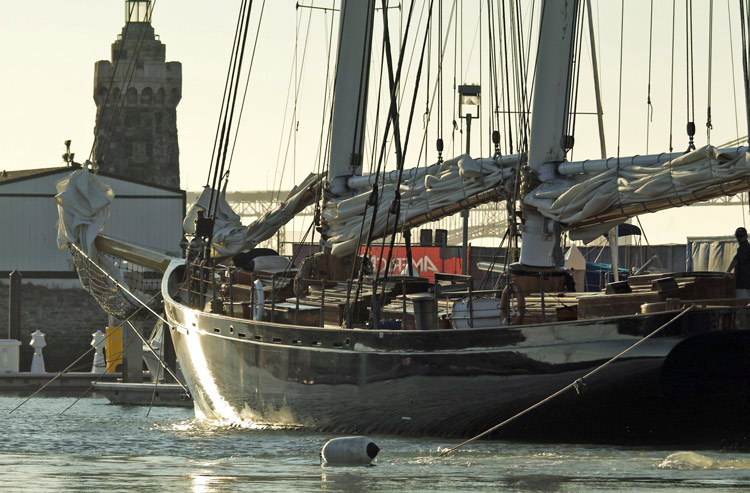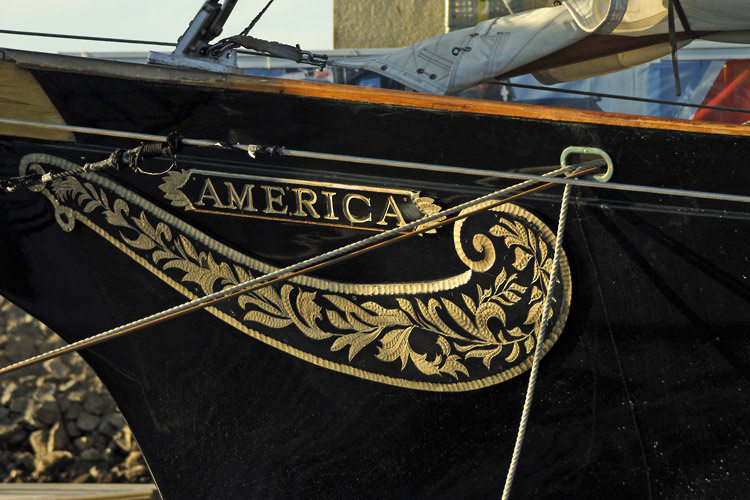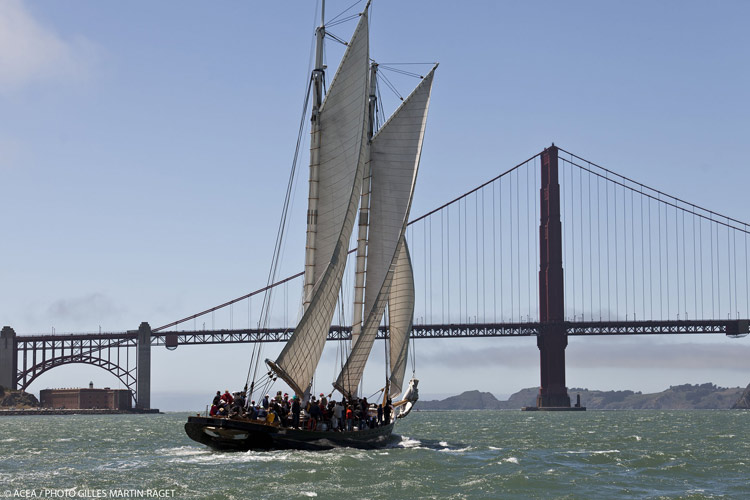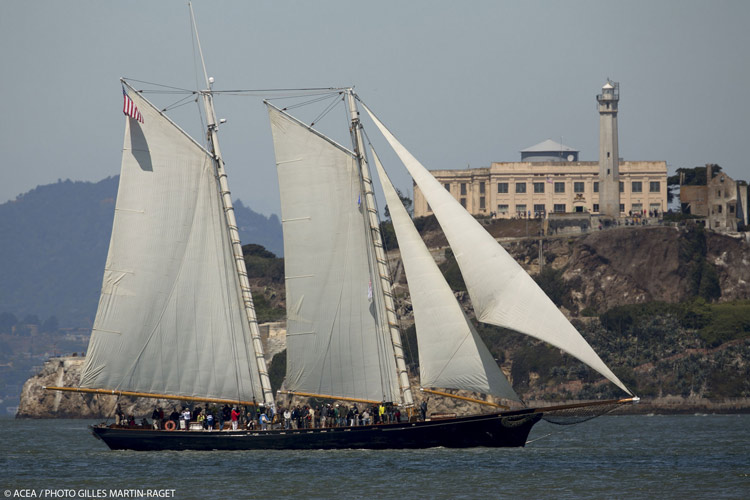Exploring the Yacht America
Letter from Yachting Historian W.P. Stephens
San Francisco, August 22, 2013

Replica of the famous low black schooner in Marina Green, San Francisco.
Image:©2013 CupInfo
William P. Stephens sent this letter to the New York
Tribune in 1921. The original yacht America, after languishing
for years in Boston, had just been donated to the US Naval Academy and
under tow made
a 19-day tour of East Cost cities large and small enroute to Annapolis, visiting on the way
New York's East River where she had been built. Stephens, a leading
yachting writer of his day and a dedicated researcher of America's
origins, took the occasion to correct the paper's coverage and point out some
relevant facts about the famed schooner's history. His letter:
|
A Letter from One Who Has Explored the Glorious Old Yacht from Stem to Stern To the Editor of the Tribune. Sir: It is gratifying as well as surprising to see a column of editorial space in a modern New York paper devoted to such subjects as the yacht America and the glories of that old time ship building which once made our city the great center of naval architecture in America. There are, however, two errors concerning the America which call for correction. She was most emphatically not a racing machine, and the trophy which has borne her name for sixty-four years was not a “Queens Cup.” The America was essentially a representative New York pilot boat, a type widely renowned in its day, in model, construction, rig and equipment. In the extraordinary departure in model from the older yachts and pilot boats of George Steers she merely followed the Mary Taylor, built by Steers in 1849 for “Old Dick Brown,” the New York pilot, who was in command of the America on her expedition to England and who was later skipper for James Gordon Bennett on his early yachts. As the yacht of a syndicate of wealthy men, she was presumably more elaborately fitted below than the working pilot boat, but externally she had all the distinctive characteristics of the type – a break in the deck just forward of the mainmast, the short counter with raking V transom, the small circular skylight just abaft the foremast, and the heavy bitts with the old log windlass. All the physical characteristics of the vessel, together with the fact that the racing machine as a type was not known for more than a quarter century later, place outside the category of Vigilant, Defender, Reliance, Resolute, and the numerous Shamrocks. The tradition of the “Queen’s Cup” found its way into the history of the America’s Cup at a very early date; one of several myths closely associated with the famous old yacht. The cup which she won was a special trophy presented by the Royal Yacht Squadron as a prize for one race open to the yachts of all nations; practically in connection with the first great world’s fair, the International Exhibition of 1851 in the then new Crystal Palace in London. The inspiration for the building and racing of the America came originally from this same exhibition. On that last trip down the East River, alluded to in The
Tribune, I had the pleasure of exploring the old craft thoroughly, starting
with an electric torch at her knightheads and ending in the dusty, musty
and rusty lazarette. In all this distance there was no single item that
could be positively identified as part of the original structure; the first
rebuilding, at Northfleet, England, about 1885; the second, at East Boston
in 1881, and the unfortunate modernization by Mr. Burgess in 1886 have
obliterated all traces of the Steer’s handiwork.
There are none of the lodging, bosom and hanging knees which formed an integral part of wooden construction, but a few diagonal knees single and in pairs on each side. There are, however, forged iron straps in each beam space, extending along the shelf with long arms on each beam, and it would seem that these may have been a part of the original construction. Nearly all of the skin is hidden by the heavy ceiling, but in one place where this had been cut away the frame was of hard oak and the planking was apparently of teak, which corroborates the report of the first rebuilding at Pilcher’s Yard, Northfleet. It is most unfortunate that no verified model or lines of this noted vessel exist to-day. While originally built from a block model, cut in the basement of the old house at 91 Cannon Street, New York, by George Steers, it is unlikely that finished plans were made, as would be the case to-day; the designer-builder working out all details as the work progressed. It is said that the custom of George Steers was to “kick” the battens on the floor: that is, as he laid down the full-size lines in the mold loft by means of long thin strips of wood held in place by awls or nails, he would move these battens in or out, thus altering at the start from the original block model. Later, when the vessel was in frame, he would go into the yard on a Sunday, look over the frames and ribbands at his leisure, and “dub” or “shim"; cutting away with an adze where the form was too full to suit him, or putting pieces of wood, “shims,” on the outer surface of the frames where the form showed slack. The result of this process was that the complete vessel might differ widely from the original model. How many sets of the true lines of the America are in existence to-day it is impossible to say; I have some seven, all vouched for on one or another authority, all different in exact detail, but most of them showing a common origin of truth and substantiating one another. While the history of the yacht from her inception to this final cruise from Boston to Annapolis is pretty clearly known, there are two points which are still obscure. It is not known just how she came into the possession of the Confederate States of America in 1861, nor when or where her tiller, which she had at the outset in common with the pilot boats of her day, was replaced by a wheel. This was probably done about the time of the first race in defense of the cup in 1870 and there is a vague report that the actual work was performed in a shipyard in Brooklyn. W.P. STEPHENS |

Image:©2013 CupInfo

Image:©2013 ACEA/Photo:
Gilles Martin-Raget

Image:©2013 ACEA/Photo:
Gilles Martin-Raget
Notes:
The yacht lay in Annapolis for the next 20 years, progressively deteriorating.
In 1942, the shed in which she was stored collapsed during a snowstorm.
There was little to salvage as a yacht, rebuilding would have meant an almost
entirely new vessel, and the imperatives of the war at the time made that option
impractical in any case. The Navy saved some timbers and other relics, and
the remains were scrapped in 1945-46, bringing about $900.
Additional historical sail and lines plans of the yacht have been discovered since Stephens wrote his letter.
-- From CupInfo.com
Additional Links and Info:
Read:
Yacht America
at Chevalier-Taglang Blog
